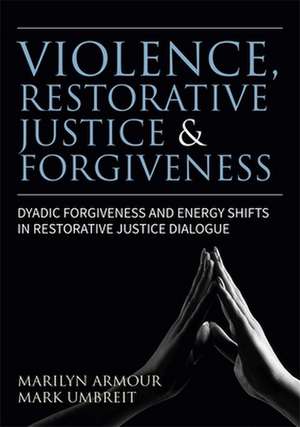Violence, Restorative Justice, and Forgiveness
Autor Marilyn Armour, Mark S. Umbreiten Limba Engleză Paperback – 18 ian 2018
The research involved interviews with 20 victims who went through a Victim Offender Dialogue (used in crimes of severe violence), and documents how the shifts in energy during the course of their dialogue moves the toxicity associated with the crime to a different place. This study explores the role of bilateral forgiveness in restorative work and addresses key questions about the role of forgiveness in restorative justice, such as how it can be measured. It also outlines a model which explains how the energy flow of dyadic forgiveness in restorative justice dialogue is formed. Rich in data and in findings, this book will deepen understanding of how restorative justice works, and will inform future research and practice in the field.
Preț: 452.41 lei
Preț vechi: 621.60 lei
-27% Nou
Puncte Express: 679
Preț estimativ în valută:
86.58€ • 89.44$ • 72.06£
86.58€ • 89.44$ • 72.06£
Carte disponibilă
Livrare economică 04-18 martie
Preluare comenzi: 021 569.72.76
Specificații
ISBN-13: 9781785927959
ISBN-10: 1785927957
Pagini: 336
Ilustrații: n/a
Dimensiuni: 182 x 247 x 18 mm
Greutate: 0.66 kg
Editura: JESSICA KINGSLEY PUBLISHERS
ISBN-10: 1785927957
Pagini: 336
Ilustrații: n/a
Dimensiuni: 182 x 247 x 18 mm
Greutate: 0.66 kg
Editura: JESSICA KINGSLEY PUBLISHERS
Cuprins
Preface; 1. Dyadic Forgiveness in Restorative Justice: A Review of the Field and a Proposed Model; 2. Victim Case Narratives and Analysis; 3. Mapping Dyadic Forgiveness: An Analysis of Positive Energy Shifts in Restorative Justice Dialogue; A. Crime and its Impact. B. Motivation and Preparation. C. Dyadic Dialogue. D. Resolution and Post Dialogue Outcomes. E. Dyadic Forgiveness; Tables and Figures; Appendices
Descriere
This major and original research project shows how restorative justice dialogue works, and highlights the role of forgiveness within it. Based on interviews of victims who went through Victim Offender Dialogue, it looks at how energy shifts in dialogue between offender and victim can lessen the toxicity associated with the crime.
